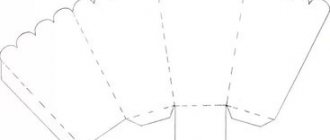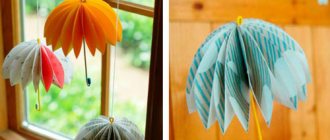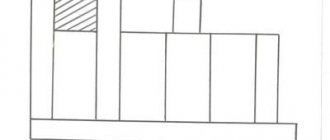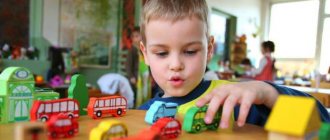LEGO building project for pre-school group. Topic: "Transport".
Transcript
1 Municipal preschool educational institution kindergarten 12 “Firefly” in the city of Galich, Kostroma region Project on construction from LEGO in a preparatory school group. Topic: "Transport". Teachers: Elena Mikhailovna Kozhina Nina Evgenievna Rasudova
2 Play generates joy, freedom, contentment, peace in oneself and around oneself, peace with the world. Friedrich Froebel. Project type: creative, short-term, group. Project implementation period: 2 weeks. Project participants: preparatory group students, teachers, parents. Project problem: to develop constructive skills in children. Relevance. Lego construction is one of the most modern areas of children's development. LEGO allows children to learn through play and learn through play. The most important thing is to provide children with the opportunity to “experience” material that is interesting to them. By learning new things, children learn to express their attitude to what is happening. By constructing, they immerse themselves in a situation organized by adults. During educational activities, children become builders, architects and creators; while playing, they come up with and implement their ideas. In the process of activity, a variety of problems are solved. While traveling, children help their friends, rescue heroes from trouble, learn interesting facts, construct, learn poems, and work according to diagrams. At the same time, children develop creative imagination, communication skills, and curiosity. The main thing is that there are no spectators, there are only
3 participants, and everyone participates with great desire. The knowledge children receive is relevant and necessary for them, and meaningful, interesting material is learned easily and forever. Project goal: To create conditions for the development of constructive activities using Lego construction sets. Project objectives: To develop in children the ability to build with Legos, choosing the right sequence of actions, joining techniques, combination of shapes and colors. Expand your understanding of transport. To consolidate an understanding of the types of transport: land, air, water, rail, special purpose. To form a sustainable interest in constructive activities, the desire to create and invent. Develop the ability to mentally separate an object into its component parts and assemble a whole from the parts. Develop imagination, constructive imagination and the ability to creatively use acquired skills. To promote the formation of mathematical knowledge about counting, shape, proportion, symmetry. Develop independence when working with diagrams. Promote the development of attention, memory, thinking, ability to concentrate. Develop fine motor skills of the hands, stimulating general speech development and mental abilities in the future. Develop a caring attitude towards Lego constructors. Cultivate perseverance, endurance, friendly relationships, respect for one’s own and other people’s work. Forms of implementation: 1. Conversation with children 2. Examination of illustrations, diagrams 3. Reading poems about transport 4. Constructive activities 5. Interaction with parents: - joint work with children - consultations - conversations
4 Implementation plan Stages of project implementation Preparatory stage Activities Selection of necessary methodological and fiction literature about transport. Preparing Lego sets and examining them. Implementation timeframe December 1 week. With parents The main stage is to create a folder for moving “Lego constructor best buildings.” Consultation: “Play with us.” Examination of illustrations, album, photographs with types of transport. Watching a cartoon based on Lego Fairy Tales. Didactic games: “Name it correctly”, Conversations: “Which type of transport do you like best”, “What do people drive”. OOD OO "R". Speech development “Writing stories about transport” OOD OO “HE”. Drawing "Drawing airplanes and helicopters." Joint and independent activities (choice of a designer set and a partner if desired). Review of schemes, distribution between children December 2nd week.
5 With parents The final stage is who will do what. Exhibition of joint drawings on the theme: “Transport”. Consultation: “The importance of Lego construction in the development of preschool children,” Exhibition of Lego transport. Children's stories about their design. Photo album “Our best buildings”. December 2nd week. Material and technical support for the project: Schemes for design. Design kits. Expected results of the project and ways to evaluate them (children) Expected results of the project Children show cognitive interest and a desire to learn everything about modes of transport. Children have developed an interest in building with Legos. Communication skills, positive habits and moral qualities are formed. Ways to track Conversations with children. Supervision of children. Organization of gaming activities. As a result of the observation, children should learn to: - construct according to diagrams; - mentally divide an object into its component parts and assemble a whole from the parts; - build various vehicles from Lego. Find out: - about many different types of transport; — how you can build cars and planes from Lego. Draw conclusions together with the teacher: - it is easier to build according to diagrams; — building with a partner is more fun; - children have a sense of self-confidence;
6 - creative imagination enriched; — interest and a positive emotional attitude towards the construction game appeared. Expected results of the project and ways to evaluate them (parents) Expected results of the project Parents are ready and able to actively interact with pegagogues on issues of children's play activities (construction games). Take an active part in the life of the group. Show interest in the results of the child’s achievements in construction games. Tracking methods Questionnaire. Participated in the design of: Exhibition “Our best buildings”. Album “Types of transport from Lego constructors”, Methods of presenting the “final result” of project activities: - Exhibition of transport from Lego. — Children's stories about their design. — Photo album “Our best buildings.”
7 Photo report Appendix
8
9
10
11
"Bus for Animals" Summary of a design lesson in the middle group
"Bus for Animals" Summary of a design lesson in the middle group
Topic: “Bus for friends.”
Target:
teach children to make an image of a bus from ready-made parts (windows, doors, wheels).
To develop their skills in folding a sheet of paper in half, aligning the sides and corners.
Strengthen the ability to glue paper parts (windows, doors, wheels) to a reference line.
Develop eye, clarity of hand movements, attention.
To instill accuracy in work in preschoolers.
Preliminary work: examination of the observation album “Buses”. Learning the song “Blue Bus”.
Materials for each child: blank bus body (sheet of cardboard with cut corners, 5 pcs squares (windows, 2 pcs strips (bus dividing strip, 2 pcs short strips (doors), 2 pcs triangles (front windows, 4 pcs circles (wheels, glue stick, napkins) , carved animal figures.
Contents of direct educational activities:
Children sit on modules. There's a knock on the door. The postman comes and brings a letter.
Educator: - Guys, we have a letter. Let's see who it's from. It was the inhabitants of the forest who sent us a letter. They really want to come to us for the Autumn holiday, but no transport goes to their forest. They ask us to help them get to our kindergarten. Shall we help?
-Guys, let's think about what types of transport you know? Children's answers: plane, helicopter, car, etc.
-Well done guys, you know many types of transport. But the animals wrote a clue in a letter to us:
What kind of miracle is the long house?
There are a lot of passengers in it
Wears rubber shoes
And it runs on gasoline.
(Bus) .
— That’s right, guys, this is a bus (the teacher takes a large paper bus out of the envelope). How can we help animals? I only have one bus, but there are many residents.
Children's answers: make more buses.
-What a great idea, let's make buses.
But first, let's look at the bus. What parts does the bus consist of? Children's answers: body, windows, doors, wheels. Where are they located?
Right. Now we will sit down at the tables. Each of you has blanks of bus parts. Let's look at them and try to put everything in its place. What will we make the body from (from a large sheet of cardboard). That's right, we need to bend it in half. So that the sides and corners touch each other.
-What shape will we make wheels (circles) from? How many are there? (4)
-Why do you think you have two long stripes? Right. To divide each side of the bus into two equal parts - in half.
-Why are there two short strips (doors)?
-What geometric shapes will you make windows from (squares and triangles).
-And what will serve as wheels (circles) for us? The wheels on both sides are at the same distance opposite each other. Pair.
Please note that on one side the bus has doors, but on the other there are no doors.
So we laid out the parts of the bus. Now let's secure it all with glue.
Educator: Guys, there are still images of animals in the envelope. Let's put every animal on the bus. Children stick pictures on bus windows.
-What a great fellow you are, you made wonderful buses. Let's play with them.
Game "Traffic lights and cars"
— Guys, you did a very useful thing today. You helped the animals get to the Autumn festival in our garden. Tell me, did you like designing buses? Well done.
The animals are very grateful to you and give you treats (juice) for this.
Get text





